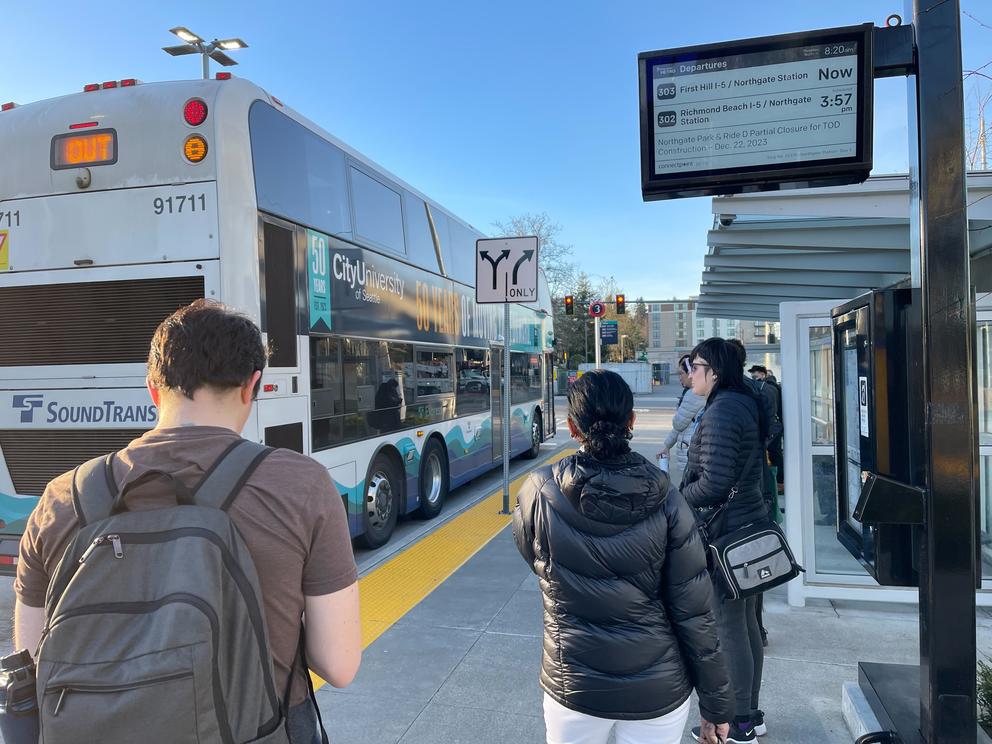As Metro looks to boost service after the pandemic lull – and adapt to new working habits – transit users turn to apps like Google Maps and the locally created One Bus Away to ensure they don’t waste time waiting for delayed buses and light rail.
As frustrating as a late or missing bus can be, the apps are only the messenger. And although Metro is working to address problem routes, some solutions may not be easy to come by. Bus systems around the region face multiple challenges, including a driver shortage, construction delays and competition from increased car traffic.
Homegrown help
One Bus Away, which has been used by more than 100,000 Puget Sound-area transit riders hoping to find out when their ride will arrive, was launched by two University of Washington doctoral students in 2008. Fourteen years later it’s still going strong, now run by a nonprofit that aims to bring accurate information to transit riders in other cities.
The nonprofit, the Open Transit Software Foundation, now provides real-time data through its app to riders in New York City, San Diego, Washington, D.C., Tampa Bay, Spokane, Buenos Aires and some smaller municipalities. The goal is to provide tools that encourage more people to ride transit.
“We’re not a transit app, we’re a research-based project,” said Kari Watkins, who helped found One Bus Away and is now a professor of civil and environmental engineering at the University of California Davis. “We’re a nonprofit. We’re completely open-source-coded. We want to be a public good.”
Originally launched by Watkins and UW computer scientist Brian Ferris, the app helps transit riders navigate Western Washington systems including King County Metro, Sound Transit, Pierce Transit, Kitsap Transit and Community Transit in Snohomish County.
Aaron Brethorst, a longtime programming volunteer for One Bus Away who became the Open Transit Software Foundation’s first executive director in January, says his organization is focused on making it easier for people to ride the bus. As in Schultheis’ case, many riders never bother to consult schedules but rely on apps to tell them when the next bus will be nearby. Brethorst notes that anyone, a programmer who commutes daily by bus or a transit agency, can access the app’s open code and make this bus location info readily available.
“You can even download the source code and change the branding to reflect the branding of your own transit agency and deploy it under your own name,” Brethorst said.
The app incorporates into an easy-to-read format GPS data from buses that has been made publicly available by transit agencies such as Metro through a format called general transit feed specification (GTFS). (Unlike Google Maps, which provides real-time bus arrival times, One Bus Away also allows users to map the location of every active bus on a route).
Watkins said that the nonprofit, which had received only small, voluntary licensing income from participating agencies such as Metro, decided in late 2023 to reach out to longtime users in the Seattle area for donations to help the organization bring the app to regions that need it most. She said this outreach brought in tens of thousands of dollars.
“I think it’s great to be in the big cities like Seattle, New York City, and D.C. That’s super-cool,” Watkins said. “But I think where we’re needed more is these smaller agencies, that they’re never going to spend a half a million dollars to create their own app.”
Making buses and light rail more consistent post-pandemic
Getting information to riders is just one strategy to make taking transit easier and more enjoyable. For their part, Metro acknowledges that the 8, which runs through some of Seattle’s most congested neighborhoods, is problematic. Katie Chalmers, managing director of service development for Metro, said the transit agency and the Seattle Department of Transportation are aware of the route’s low on-time performance and are looking for solutions, including additional bus-only lanes.
“When Amazon employees returned to in-office work, it caused notable traffic changes and ridership changes that have influenced that route,” Chalmers said. “It’s going to take a strong partnership to be able to continue to work through some of that.”
The 8 currently has an overall on-time rate of about 75 percent – but the rate varies significantly depending on when and which direction you’re traveling. During peak travel times eastbound on weekday afternoons, the on-time rate for the 8 dipped to a low of just 30 percent last June.
“It’s very congested here,” Schultheis said of her homeward commute.
In general, on-time performance at Metro is around 80 percent, which has remained fairly consistent over the past five years, according to Metro’s rider data dashboard. The number of passengers riding Metro each weekday has climbed steadily since the onset of the pandemic in early 2020 – in February 2024, 291,000 people on average rode Metro’s buses each weekday, up from 267,000 one year earlier. That’s still well below pre-pandemic levels from February 2020, when the system averaged 510,000 weekday riders.
While many businesses have returned to at least partial in-office work, changes in commuters’ travel habits have definitely had an impact on how Metro schedules its routes, during both traditional weekday morning and afternoon commutes and at other times.
“We’re seeing a long-term shift towards providing frequent service all day and on weekends,” Chalmer said. “That’s a direction that Metro had envisioned even before the pandemic. What we’ve seen is an acceleration of trends that point in the direction of an all-day frequent network as the goal.”
In 2023, Metro reduced scheduled bus service by about 4 percent across the county to balance ridership decreases and difficulties hiring and retaining drivers and bus mechanics. As reported last year, in spring 2023 Metro faced a shortage of 120 full-time drivers and 40 bus maintenance and repair staff.
Last August, Metro and Amalgamated Transit Union Local 587 agreed to a new three-year labor contract covering about 4,000 transit employees, raising wages a total of 17 percent, offering current drivers a retention bonus of $2,000 and giving new drivers and mechanics a $3,000 signing bonus.
That contract, in tandem with more vigorous recruiting efforts, has made a dent in Metro’s deficit of drivers, Chalmers said. “Since January, we’ve had seven classes and 65 new folks coming into operator training,” she said, up from a previous average of about 25 per month. “We’ve basically increased the pipeline of people coming into Metro for bus operator training.”
Boosting service and opening new lines
If Metro continues to see improvement in the availability of drivers and mechanics, Chalmers said, the agency is hoping to announce service increases in August. That timing is important because three new major transit infrastructure projects in the region are coming this year: the opening of Sound Transit’s Eastside Link light-rail line in April; the extension of the Link 1 Line from Northgate to Lynnwood; and the unveiling of Metro’s long-awaited Rapid Ride G Line on Madison this fall.
A real-time schedule kiosk for SDOT’s streetcar on Capitol Hill. Transit agencies in the region have been struggling to keep buses and trains running on time with a shortage of drivers and mechanics. A new contract for Metro employees signed last August raised wages and is helping improve recruitment. (Andrew Engelson for Cascade PBS)
The Rapid Ride G Line, which has been in the works for a dozen years, involved a $134 million, three-year SDOT construction project to completely repave or add sidewalks, stops and bus-only lanes along Madison Street. When complete, the G line will offer buses every six minutes for most of the day on weekdays, connecting Madison Valley, Capitol Hill, and downtown. The route will partly overlap the 8, so the new service could provide a bit of relief for the beleaguered line.
“This will be Metro’s most frequent route service,” Chalmers said of the G Line.
Meanwhile, although Sound Transit has yet to formally announce when the extension of its Link Line 1 north to Lynnwood will open, it’s likely to be in early fall, said spokesperson David Jackson.
As happened when the line to Northgate opened in 2021, Sound Transit anticipates a large surge in rider demand. “We’re expecting that it could be crowded when Lynwood opens,” Jackson said. “So we’re probably going to run some redundant bus service from Snohomish County to Seattle, that we normally would get rid of.”
Chalmers said Metro is currently working on plans to increase bus service near the four new light-rail stations. “Bringing people to and from those stations is a real focus,” she said. Community Transit in Snohomish County is also planning to boost bus service near the stations, and next week will debut its new rapid-ride Swift Orange Line connecting Edmonds, Lynnwood, Mill Creek, and Everett.
Other challenges and solutions
One issue that has bedeviled Sound Transit in recent years is an assortment of aging elevators and escalators in central stations like Westlake. Jackson said that by cobbling together parts from various sources, the agency currently has a 90 percent functioning rate for escalators and elevators at Downtown stations, and plans extensive replacement work at the International District station this year.
In addition, Sound Transit’s Eastside Link extension will open in late April, but will connect only 10 stations over 14 miles between Bellevue and Redmond. The rail route on the I-90 bridge over Lake Washington – which will eventually connect the Eastside to Seattle and the north/south 1 Line – was delayed because of faulty concrete “plinths” that support the rail lines.
The lack of that connection to the Eastside has caused a pesky problem for the Lynnwood Link line: Because a new train service center in Bellevue isn’t currently accessible to that line, and because space is limited at Sound Transit’s other service base in Georgetown, peak service between Northgate and Lynnwood on the light rail was originally expected to run only every 10 minutes. Sound Transit recently announced it’s found workarounds that will enable trains to run every 8 minutes during peak service hours on the Lynnwood line, mostly through longer trains and creative use of space at its existing service center.
Like Metro, Sound Transit provides data to apps like One Bus Away and is trying to improve its accuracy, knowing that nothing frustrates transit users so much as long wait times or missing trains and buses. “That data changes pretty frequently when we have service disruptions or a service change,” Jackson said. “But we work pretty hard to make sure that the real-time data is indeed real-time.”
In the meantime, riders like Schultheis will look at their phones and hope the wait for the next connection isn’t too long.







